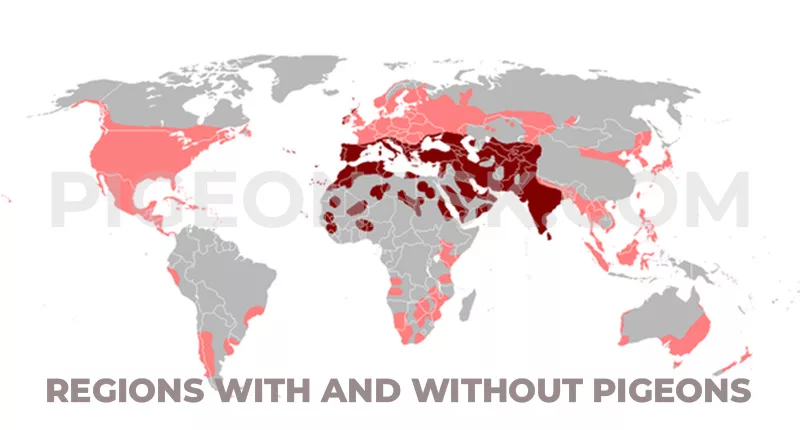Why Are Pigeons Everywhere?
World travelers, biologists, and your average observer have one thing in common − they have, at one point, asked themselves or their peers, why are pigeons everywhere?
Pigeons are everywhere because we carried them everywhere we have migrated to since ancient times. Before that, theoretically, they came to us in search of food, and in turn, we also used them as food sources and other utilities, such as spotting lands and carrying messages.
Like most of our relationship with nature, it was quite symbiotic. They needed us, and we needed them. It is only now that we have outgrown their utilities.
Although many people still keep pigeons as pets, the vast majority of pigeons are feral and left to fend for themselves in our cities, towns, and countryside.

Read more about pigeon blogs:
Are Pigeons Everywhere in the World?
Biologists claim that pigeon ancestors originate from North African shores. From there, the rock doves would start living close to human settlements due to the availability of leftover grains and seeds. As generations of human beings and birds lived and died in close proximity, these birds evolved into the pigeons that we know today.
Historically, people brought pigeons everywhere they went. Since pigeons breed all year around and you only need one pair of pigeons to start a flock, it made sense to have these birds around as a stable food source.
Over time we came to depend on these birds, not just as a food source but also for their navigational skills. This skill was greatly in use when sending messages to other settlements or when ships had to find the coast.
As a result of our reliance on them, we have treated them with the same importance as we have given to other important animals such as horses, dogs, and even cattle.
So whenever human beings migrate to a new area, say from the Middle East to Europe or deeper into Asia, we have to take pigeons with us. Either as our own pets, a source of poultry, or as feral flocks that live near human settlements.
Regions With and Without Pigeons
These days, rock doves and pigeons are considered to be the natives of the Middle East, India, North Africa, Southern Europe, and Central Asia.
While native to these regions, they have been introduced to pretty much the rest of the world. In areas close to their native lands, they just moved to where the people are.

It is fair to say that pigeons thrive almost everywhere as long as the climate is not too hot or cold.
On the other hand, it would be inaccurate to say that pigeons are now native everywhere where there are people.
Many countries in north and central South America, Iceland, Papua New Guinea, the Pacific Islands, Madagascar, and central Africa, do not host these birds.
However, domesticated pigeons have been a staple in the pet bird criteria for a thousand years.
It would be quite inaccurate to say that these countries have no pigeons, as it is more than likely that they exist in those countries as pets or poultry.
Why Do Cities Have So Many Pigeons?
Pigeons have managed to take over urban areas from Washington, London, Mumbai, and Melbourne to name a few. If the climate permits, pigeons can thrive almost anywhere in the world.

Pigeons are more prevalent in cities than in other places for the following reasons:
Habitat
Rock doves, pigeon ancestors, were originally natives of the North African shores.
It is on these rocky cliffs and ledges our feather friends first made their nests. As such, they have a natural inclination towards hard surfaces.
Now that we know this, it doesn’t really take a scientist to deduce how pigeons acclimate themselves so well in the concrete jungles of our urban settlements.
According to pigeon expert and author Jerolmack, pigeons actually like concrete, marble, and stones.
So, as opposed to nesting on treetops, shrubs, and grass, pigeons nest alongside buildings.
Diet
Pigeons are highly adaptable birds, and their unique diets add fuel to their adaptability.
While most birds have a sole reliance on bugs, grains, seeds, fruits, and berries, pigeons are able to eat and digest just about any foodstuff human beings throw away.
Steve Portugal, a comparative ecophysiologist, says that −”As a result of this rare ability, pigeons in urban dwellings have an overabundance of food supply and rarely go to bed hungry.”
Pigeon chicks are fed a special diet of protein and fat-rich milk called crop milk. This milk is produced inside a throat pouch, called the crop, of both the parent pigeons.
As such, pigeons are not reliant on bugs, worms, or grains to feed their offspring.
This gives pigeons an edge over other birds because the aforementioned food sources are rarely in abundance in cities.
In Portugal’s own words, as long as the adults eat, they can feed their babies.
How Did Pigeons Get to America?
Rock doves reached the North American shores around the 1600s. They are non-native to these lands and were transported across the Atlantic by the thousands.
Although these birds were already considered a food source, they were not brought over for farming purposes.

According to paleontologist Michael Habib of the Dinosaur Institute at the Los Angeles County Museum of Natural History and the University of Southern California, they were brought over for hobby breeding.
Eventually, these hobby birds escaped captivity and began to roam and breed freely around American cities.
As per Habib −”Since they were evolved, with help from us, to thrive in urban habitats, and live comfortably around human beings, it’s no surprise that American pigeon populations are as high as they are today.”
Final Words
Overall, after much research and discussion, we can surmise the major reasons behind the overabundance of pigeons in the world.
Pigeons and human beings have an ancient symbiotic relationship akin to dogs. They lived near us or with us for food, and we used them as a rich source of protein or as messengers and maritime navigational tools.
Everywhere human beings migrated, from the Americas to South and SouthEast Asia, our feathered companions have traveled with us.
All these factors, combined with their strong sense of survival and adaptability, is the reason why we see pigeons everywhere.
Did this article tickle your intellectual needs? If yes, then go visit our socials for more. If not, then go visit our Facebook, Twitter, and Pinterest to satisfy your thirst for answers. Please share this article if you enjoyed reading it.
Article References:
- Washingtonpost.com/lifestyle/kidspost/ever-wondered-why-cities-have-so-many-pigeons/2019/06/07/ffad4918-83b9-11e9-95a9-e2c830afe24f_story.html
- En.wikipedia.org/wiki/Rock_dove
- Kids.britannica.com/students/article/pigeon-and-dove/276421
- Businessinsider.com/how-pigeons-took-over-american-cities-new-york-city-habitat-2019-6
- Livescience.com/63923-why-cities-have-so-many-pigeons.html
Image Credits:
- Creativecommons.org/licenses/by/3.0/
- Discoverwildlife.com (By Richard Baker/In Pictures/Getty)
- Canva.com/photos (By Cherryshot)
